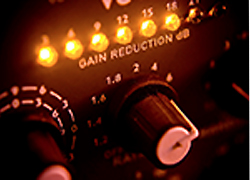What is dynamic processing?
A dynamic processor is something that outputs a signal, where the level of the outgoing signal is based on the level of the incoming signal.
In other words, a loud signal coming in will come out differently than a quiet signal coming in.
Basic Types of Dynamic Processors
Compressors: The most common – the louder the signal is coming in, the less level it provides going out. In a compressor, a target level is set – called the “threshold” – and any signal coming in that exceeds that level will be reduced. The higher the level is above that threshold, the more reduction will occur. More on this later.
Limiters: Limiters are like super compressors. The idea is to ensure that the level does not exceed the threshold. Because this amount of compression is extreme, a limiter relies on certain functions and design that regular compressors do not have.
Expanders: The quieter the signal is coming in, the less level it provides going out. In other words – it makes quiet signals even quieter. Much like a compressor, the threshold is set at a certain level. Any signal that does NOT exceed that threshold is reduced, and the quieter the signal, the more reduction is done.
Gates: Gates are like super expanders. Anything that does not exceed the threshold is reduced to inaudible. Again, because gates are extreme, they often require a slightly different design than a regular expander.
Now – I’ll focus primarily on compression, because that’s going to be the most commonly used dynamic processor.
Compression
Every signal you hear is compressed??? Yes, every signal you hear is compressed.
Bare with me. Imagine you have a rapper in front of a microphone. The rapper raps, you record. You play it back. You haven’t used any processing – you’re just playing back the raw vocals.
You are listening to a signal that has gone through at bare minimum 3 stages of compression – and more likely than not – closer to 6.
—The microphone capsule gains tension as the rappers voice pushes it – in other words – it pushes back. The more the rapper’s voice pushes in – the harder the capsule diaphragm pushes back. In other words, the louder the signal is hitting the capsule, the more reduction the capsule does to the signal. That’s compression! (It’s mild compression, but it’s still compression).
—Along the way through the microphone, you may hit a tube. Tubes have a non-linear response to voltage – the response is quite curved, and also changes the frequency balance of the signal. This is called saturation – which will tend to “round out” a signal, by reducing the loudest peaks. Compression! And before leaving the microphone, the signal may hit a transformer as well, which will saturate in a similar way… more compression.
—The preamp is going to have multiple stages of saturation – and often times, the more gain you give something – the deeper that saturation curve goes. In other words, the more you drive the signal at the preamp, the more compression the signal experiences.
—Then the sound has to actually come out of the speaker cones. Well, those speaker cones are going to build up tension when pushed further. See where this is going? This is called “cone compression”.
OK – so this is a bit of a simplification – but there’s a point here. The point is that “compression” is always part of the signal. Some mics have less of it, some have more – same with speakers, tubes, transformers, etc. And they all do it in different ways.
With tubes, people will talk about their saturation curves and %THD (total harmonic distortion – or frequency alterations). With mics, people will refer to how it “grabs” a sound – or more specifically – the sound’s shape.



















